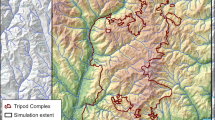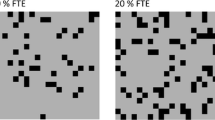Abstract
Techniques for modeling burn probability (BP) combine the stochastic components of fire regimes (ignitions and weather) with sophisticated fire growth algorithms to produce high-resolution spatial estimates of the relative likelihood of burning. Despite the numerous investigations of fire patterns from either observed or simulated sources, the specific influence of environmental factors on BP patterns is not well understood. This study examined the relative effects of ignitions, fuels, and weather on mean BP and spatial patterns in BP (i.e., BP variability) using highly simplified artificial landscapes and wildfire simulation methods. Our results showed that a limited set of inputs yielded a wide range of responses in the mean and spatial patterning of BP. The input factors contributed unequally to mean BP and to BP variability: so-called top-down controls (weather) primarily influenced mean BP, whereas bottom-up influences (ignitions and fuels) were mainly responsible for the spatial patterns of BP. However, confounding effects and interactions among factors suggest that fully separating top-down and bottom-up controls may be impossible. Furthermore, interactions among input variables produced unanticipated but explainable BP patterns, hinting at complex topological dependencies among the main determinants of fire spread and the resulting BP. The results will improve our understanding of the spatial ecology of fire regimes and help in the interpretation of patterns of fire likelihood on real landscapes as part of future wildfire risk assessments.





Similar content being viewed by others
References
Ager AA, Finney MA, McMahan D (2006) A wildfire risk modeling system for evaluating landscape fuel treatment strategies. In: Andrews PL, Butler BW (compilers) Fuels management—how to measure success. Proceedings RMRS-P-41, Portland, OR, 28–30 March 2006. USDA Forest Service, Rocky Mountain Research Station, Fort Collins
Badia-Perpinyà A, Pallares-Barbera M (2006) Spatial distribution of ignitions in Mediterranean periurban and rural areas: the case of Catalonia. Int J Wildland Fire 15:187–196
Baker WI (1994) Restoration of landscape structure altered by fire suppression. Conserv Biol 8:763–769
Barclay HJ, Li C, Hawkes B, Benson L (2006) Effects of fire size and frequency and habitat heterogeneity on forest age distribution. Ecol Model 197:207–220
Beverly JL, Martell DL (2005) Characterizing extreme fire and weather events in the Boreal Shield ecozone of Ontario. Agric For Meteorol 133:5–16
Bond WJ, van Wilgen BW (1996) Fire and plants. Chapman and Hall, London
Burnham KP, Anderson DR (1998) Model selection and inference: a practical information-theoretic approach. Springer, New York
Cary GJ, Keane RE, Gardner RH, Lavorel S, Flannigan MD, Davies ID, Li C, Lenihan JM, Rupp TS, Mouillot F (2006) Comparison of the sensitivity of landscape-fire-succession models to variation in terrain, fuel pattern, climate and weather. Landscape Ecol 21:121–137
Clark RE, Hope AS, Tarantola S, Gatelli D, Dennison PE, Moritz MA (2008) Sensitivity analysis of a fire spread model in a chaparral landscape. Fire Ecol 4:1–13
Dutilleul P (1993) Modifying the t test for assessing the correlation between two spatial processes. Biometrics 49:305–314
Falk DA, Miller C, McKenzie D, Black AE (2007) Cross-scale analysis of fire regimes. Ecosystems 10:809–823
Finney MA (2001) Design of regular landscape fuel treatment patterns for modifying fire growth and behavior. For Sci 47:219–228
Finney MA (2003) Calculation of fire spread rates across random landscapes. Int J Wildland Fire 12:167–174
Finney MA (2006) An overview of FlamMap fire modeling capabilities. In: Andrews PL, Butler BW (compilers) Fuels management—how to measure success. Proceedings RMRS-P-41, Portland, OR, 28-30 March 2006. USDA Forest Service, Rocky Mountain Research Station, Fort Collins
Forestry Canada Fire Danger Group (1992) Development and structure of the Canadian Forest Fire Behavior Prediction System. Forestry Canada, Fire Danger Group and Science and Sustainable Development Directorate, Ottawa 64 pp
Gavin DG, Hu FS, Lertzman K, Corbett P (2006) Weak climatic control of stand-scale fire history during the late holocene. Ecology 87:1722–1732
Heyerdahl EK, Brubaker LB, Agee JK (2001) Spatial controls of historical fire regimes: a multiscale example from the interior west, USA. Ecology 82:660–678
Keane RE, Agee JK, Fulé P, Keeley JE, Key C, Kitchen SG, Miller R, Schulte LA (2009) Ecological effects of large fires on US landscapes: benefit or catastrophe? Int J Wildland Fire 17:696–712
Kerby J, Fuhlendorf S, Engle D (2007) Landscape heterogeneity and fire behavior: scale-dependent feedback between fire and grazing processes. Landscape Ecol 22:507–516
Krawchuk MA, Cumming SG, Flannigan MD, Wein RW (2006) Biotic and abiotic regulation of lightning fire initiation in the mixedwood boreal forest. Ecology 87:458–468
Krawchuk MA, Moritz MA, Parisien M-A, Van Dorn J, Hayhoe K (2009) Global pyrogeography: the current and future distribution of wildfire. PLoS ONE 4(4):e5102. doi:10.1371/journal.pone.0005102
LaCroix JJ, Ryu S-R, Zheng D, Chen J (2006) Simulating fire spread with landscape management scenarios. For Sci 52:522–529
Leohle C (2004) Applying landscape principles to fire hazard reduction. For Ecol Manag 198:261–267
Lertzman K, Fall J, Dorner B (1998) Three kinds of heterogeneity in fire regimes: at the crossroads of fire history and landscape ecology. Northwest Sci 72:4–23
McKenzie D, Hessl AE, Kellogg L-KB (2006) Using neutral models to identify constraints on low-severity fire regimes. Landscape Ecol 21:139–152
Miller C (2003) The spatial context of fire: a new approach for predicting fire occurrence. In: First national congress on fire ecology, prevention and management. San Diego, CA, 28 November–1 December. Tall Timbers Research Station, Tallahassee
Moritz MA (1997) Analyzing extreme disturbance events: fire in Los Padres National Forest. Ecol Appl 7:1252–1262
Moritz MA (2003) Spatiotemporal analysis of controls on shrubland fire regimes: age dependency and fire hazard. Ecology 84:351–361
Moritz MA, Morais ME, Summerell LA, Carlson JM, Doyle J (2005) Wildfires, complexity, and highly optimized tolerance. Proc Natl Acad Sci USA 102:17912–17917
Nagelkerke NJD (1991) A note on a general definition of the coefficient of determination. Biometrika 78:691–692
Niklasson M, Granström A (2000) Numbers and sizes of fires: long-term spatially explicit fire history in a Swedish boreal landscape. Ecology 81:1484–1499
Nunes MCS, Vasconcelos MJ, Pereira JMC, Dasgupta N, Alldredge RJ, Rego FC (2005) Land cover type and fire in Portugal: do fires burn land cover selectively? Landscape Ecol 20:661–673
Parisien M-A, Moritz MA (2009) Environmental controls on the distribution of wildfire at multiple spatial scales. Ecol Monogr 79:127–154
Parisien M-A, Hirsch KG, Lavoie SG, Todd JB, Kafka V (2004) Saskatchewan fire regime analysis. Natural Resources Canada, Canadian Forest Service, Northern Forestry Centre, Edmonton 49 pp
Parisien M-A, Kafka V, Hirsch KG, Todd JB, Lavoie SG, Maczek PD (2005) Mapping wildfire susceptibility with the BURN-P3 simulation model. Natural Resources Canada, Canadian Forest Service, Northern Forestry Centre, Edmonton 36 pp
Parisien M-A, Junor DR, Kafka VG (2007) Comparing landscape-based decision rules for placement of fuel treatments in the boreal mixedwood of western Canada. Int J Wildland Fire 16:664–672
Peterson GD (2002) Contagious disturbance, ecological memory, and the emergence of landscape pattern. Ecosystems 5:329–338
Rollins MG, Morgan P, Swetnam T (2002) Landscape-scale controls over 20th century fire occurrence in two large Rocky Mountain (USA) wilderness areas. Landscape Ecol 17:539–557
Russell-Smith J, Yates C, Edwards A, Allan GE, Cook GD, Cooke P, Craig R, Heath B, Smith R (2003) Contemporary fire regimes of northern Australia, 1997–2001: change since aboriginal occupancy, challenges for sustainable management. Int J Wildland Fire 12:283–297
Stambaugh MC, Guyette RP (2008) Predicting spatio-temporal variability in fire return intervals using a topographic roughness index. For Ecol Manag 254:463–473
Sturtevant BR, Cleland DT (2007) Human and biophysical factors influencing modern fire disturbance in northern Wisconsin. Int J Wildland Fire 16:398–413
Syphard AD, Radeloff VC, Keeley JE, Hawbaker TJ, Clayton MK, Stewart SI, Hammer RB (2007) Human influence on California fire regimes. Ecol Appl 17:1388–1402
Taylor AH, Skinner CN (2003) Spatial patterns and controls on historical fire regimes and forest structure in the Klamath Mountains. Ecol Appl 13:704–719
Turner MG, Gardner RH, Dale VH, O’Neill RV (1989) Predicting the spread of disturbance across heterogeneous landscapes. Oikos 55:121–129
Tymstra C, Bryce RW, Wotton BM, Armitage OB (2009) Development and assessment of the Prometheus fire growth simulation model. Natural Resources Canada, Canadian Forest Service, Northern Forestry Centre Information Report, Edmonton, AB. Report No. NOR-X-417 (in press).
Van Wagner CE (1987) Development and structure of the Canadian Forest Fire Weather Index System. Canadian Forest Service, Ottawa, p 35
van Wagtendonk JW, Cayan DR (2008) Temporal and spatial distribution of lightning strikes in California in relation to large-scale weather patterns. Fire Ecol 4:34–56
Wimberly MC (2004) Fire and forest landscapes in the Georgia Piedmont: an assessment of spatial modeling assumptions. Ecol Model 180:41–56
Yang J, He HS, Sturtevant BR, Miranda BR, Gustafson EJ (2008) Comparing effects of fire modeling methods on simulated fire patterns and succession: a case study in the Missouri Ozarks. Can J For Res 38:1290–1302
Acknowledgments
This work was supported by a Joint Fire Sciences Program grant to the authors. We are grateful to Brett Davis for assistance with geographic information systems and to Meg Krawchuk, Max Moritz, Erica Newman, and Diana Stralberg and two anonymous reviewers for providing constructive comments.
Author information
Authors and Affiliations
Corresponding author
Rights and permissions
About this article
Cite this article
Parisien, MA., Miller, C., Ager, A.A. et al. Use of artificial landscapes to isolate controls on burn probability. Landscape Ecol 25, 79–93 (2010). https://doi.org/10.1007/s10980-009-9398-9
Received:
Accepted:
Published:
Issue Date:
DOI: https://doi.org/10.1007/s10980-009-9398-9




